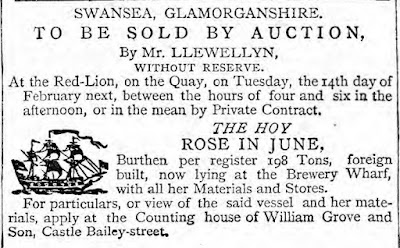Auctions - Lost articles from April 2020
Picture the scene. A local estate agent, holds an auction, selling a variety of properties and buildings situated around Swansea and the local area. The auctioneer, standing at podium, gavel in hand, introduces himself and welcomes the public to the public auction. He makes start with Lot 1. “I have the delight to offer this semi-detached property situated at ………. This property consists of two well sized reception rooms, 3 bedrooms. The starting price is £120,000. Who will give me £125,0000? Thank you, madam,…….”
Easter time normally is the start of the estate agent busiest period of the year. Estate agents are those who arrange the selling, renting, or the management of properties and other buildings. This has not always been the case.
 |
| Map of the New Estate at Towmhill |
During this start of the Roaring Twenties, 80% of people rented their homes, usually from private landlords. The Housing, Town Planning, &c. Act 1919, had been passed by Parliament. The Act provided local authorities with subsidies to help finance the construction of houses. Here in Swansea this could been seen with construction of houses at Townhill, working from layout of ambitious plans. These plans had been drawn as early as 1912, by the town planner, Sir Raymond Unwin and Swansea Borough Surveyor George Bell. A row of six experimental houses had been completed in 1914.
During the 1930s housing building peaked to 350,000 in
England and Wales. During this decade, outer
town suburbs were established, with the spacious 3-bedroom semi-detached houses. 2 million houses were destroyed during the
German blitzkrieg in the UK. Following the
1945 peace 157,000 prefabricated houses were built, throughout the UK, to meet
the needs of the housing shortage. Prefab houses in Swansea were situated in Gendros,
Townhill and West Cross. A further Act was passed, Housing (Financial
and Miscellaneous Provisions) Act 1946, which saw by 1951 the completion of
over 800,000 properties built by local authorities. Housebuilding
peaked again the following decade 1960s, both in private and council properties.
With the private properties, being sold,
the estate agents came into their own. Properties’
value during the 1950s were £2,000 (£48,000), this rising to £5,000 (£55,000)
in the 1970s. The reality of owning house
during the 1980s, was seen in the Right to Buy Policy.
However, auctions have not always been about selling properties. The word “auction” derives from the
Latin, auctum. During the 17th
century, they were sporadic and relatively uncommon. It was common practise to either haggle or have
a set price. The two major auction houses
to have been established in London, were Sotheby’s, 1744 and Christie’s, 1766. Taverns and coffeehouses were used also to
hold auctions during the 18th century.
 |
| The Cambrian 28th January 1804 |
28th January 1804, The Cambrian Newspaper, published an auction held at the Red Lion, St. Thomas. The auctioneer, Mr Llewellyn, selling without any reserve The Hoy, 198-ton ship. Ship auctions before this time were conducted by an Auction by the Candle. Bids were placed on the table. The highest bid by the time the candle had burnt out won.
 |
| Hunt & Co Directory Gloucester & Bristol, 1849 |
Trade directories can hold a good source of information. 1849 Hunt & Co. Directory of Gloucester & Bristol lists for Swansea 9 Auctioneers and Appraisers. Bennett’s Business Directory, of 1900, lists 19. 1912, this number drops to 17 listed in the Wales Trade Directory, however, also listed are 15 Estate Agents. Two of these Auctioneers stood out, being John M. Leeder & Son, 46 Waterloo Road and A. Samuel, Gower Street.
 |
| Bennett's Business Directory 1900 |
 |
| Wales Trade Directory 1900 |
 |
| Wales Trade Directory 1900 |
The first auctioneer, John M. Leeder prior to being an
auctioneer was J. H. Vivian’s agricultural surveyor, his responsibilities of
the time was the planting and development of Singleton estate. 1859, Leeder established his own business as
a surveyor and estate agent a few years after Vivian’s death. Leeder’s first instruction was to let 3 &
4 Gloucester Place. Ernest, his son,
joined the business as a partner in 1880.
John died in 1911, in Herefordshire, aged 84. Its
Leeder’s other son, John Viner Leeder, a solicitor; Swansea Borough Corner from
1900-1910 and Councillor. In February’s edition,
Mumbles Railway Remembered, Leeder, was suing the Swansea and Mumbles Railway
in 1894. John died in April 1912, aged
49, a few days before the maiden voyage of R.M.S. Titanic.
The second auctioneer, the well-known A. Samuel, Astley Samuel. Samuel and his family were residing at Eaton Crescent at the time of the 1911 Census. He was the son of William Samuel and Ann James. He is known to have a further 6 siblings one of whom was Owen Wilmore Samuel. Owen, whom previously was employed at Ben Evans. By the time of the 1901 Census, commercial clerk Owen, resided at Sheffield. Later in the same year married and went off to sea. By the time of the 1911 census, the family had moved from Sheffield to Southampton. 4th April 1912, second-class saloon steward Owen Samuel, signed on with the R.M.S. Titanic. Sadly, Owen lost his life during the sinking of the 15th April. The Mackay-Bennett recovered his body. He was finally buried at Fairview Lawn Cemetery, Halifax.
Auction houses have moved with the times with the technological
advancements of the modern times. People
can attend and participant the auction from the comfort of their own
homes. One well known online auctions sites, is eBay.
Leap year 2004, a Swansea disgruntled student, in protest to the introduction of
the higher tuition fees, placed Swansea University ‘for sale’, starting price
of £50. The auction was closed with 9 days
left to go; the bid has risen to £54.89.
If you have any interesting family stories of auctions and
auctioneers do get in touch.



Comments
Post a Comment